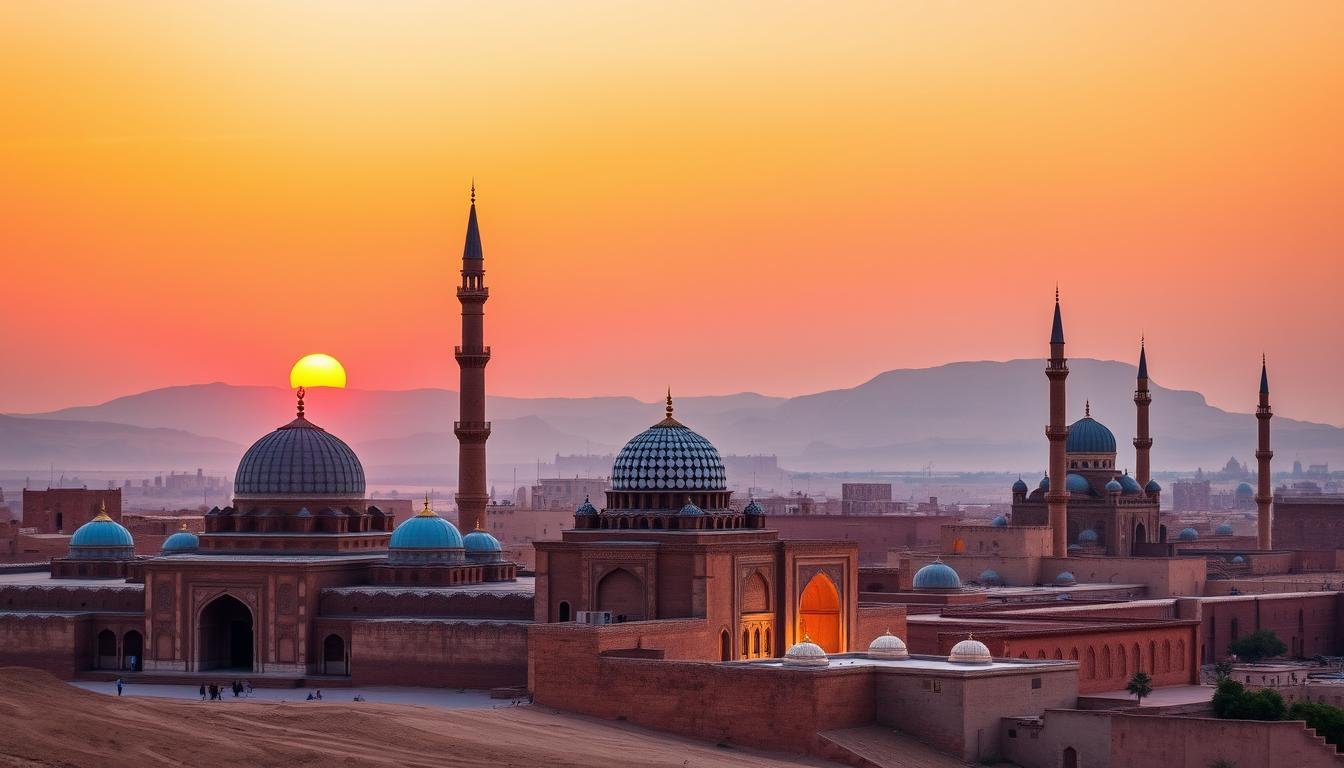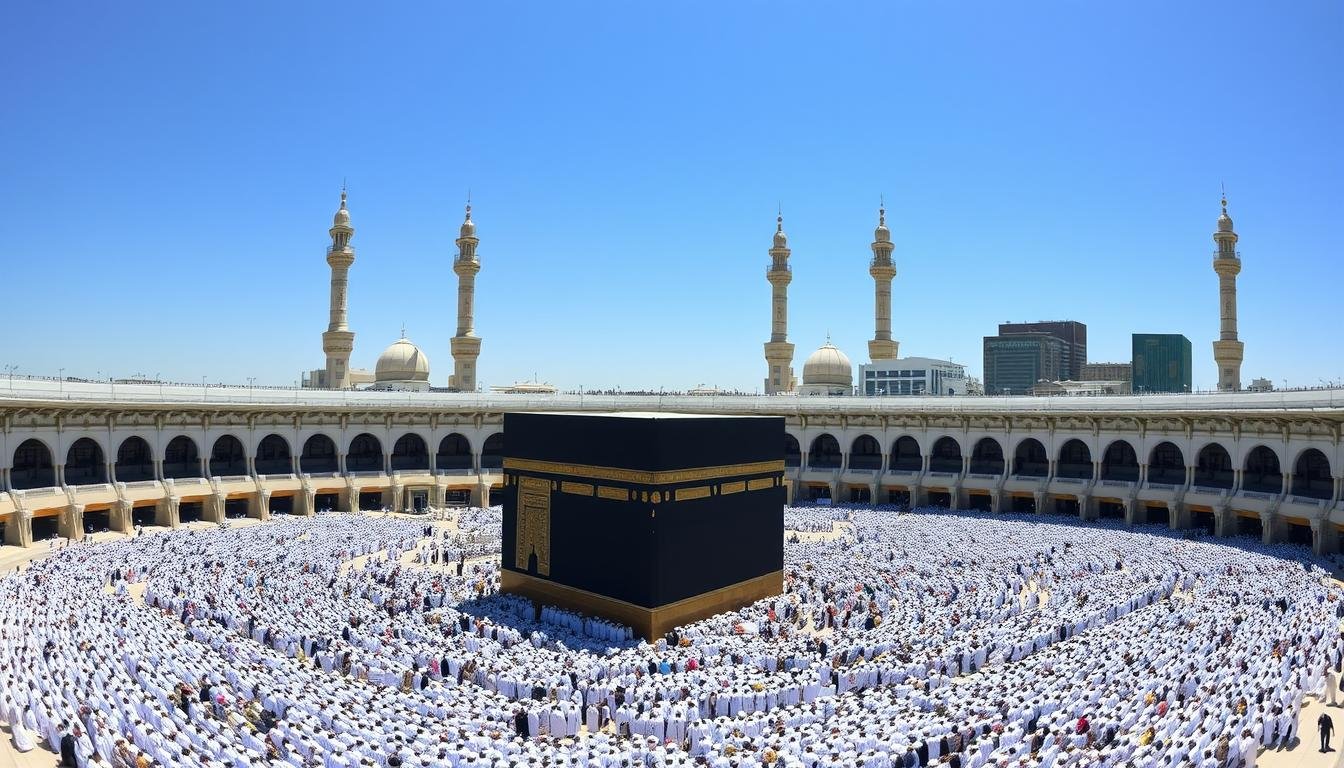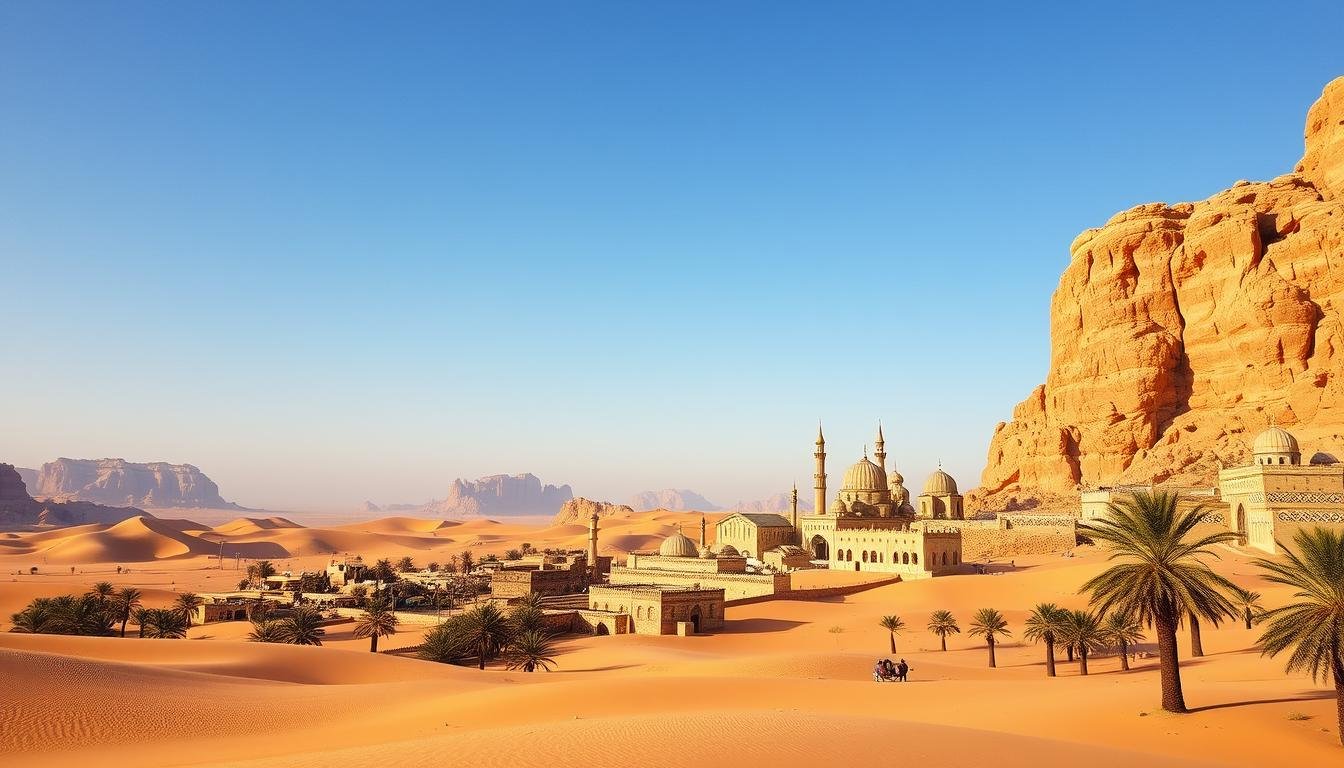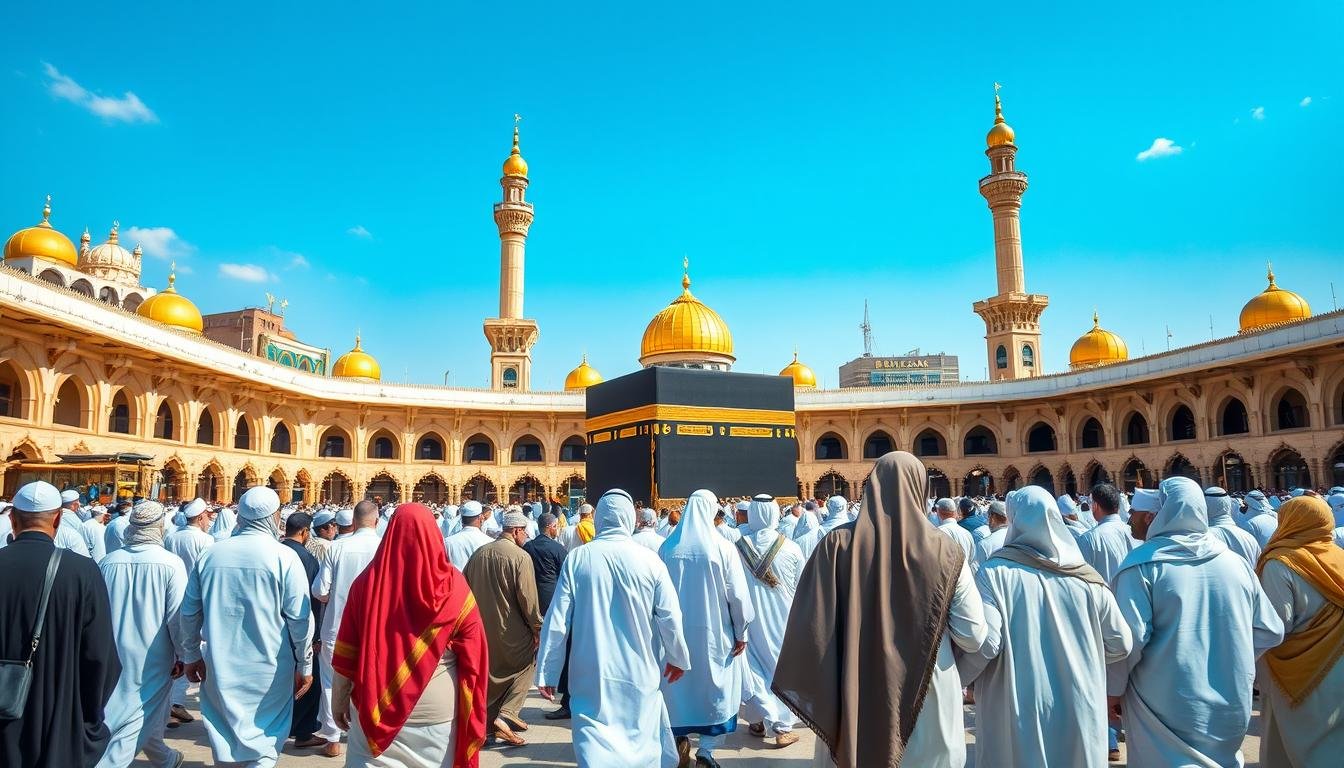Imagine stepping back in time, surrounded by the timeless elegance of ancient mosques. These mosques have seen the rich history and unwavering faith of the Arabian Peninsula. As I explore, I wonder: what secrets do these architectural marvels hold? How have they shaped the story of Islamic heritage in Saudi Arabia?
The historic mosques of Saudi Arabia are a testament to the enduring power of faith. They showcase the evolution of Islamic architecture. Join me as we uncover the hidden gems, architectural styles, and cultural influences that have defined these sacred spaces over the centuries.
Discovering the Historic Mosques of Saudi Arabia
The historic mosques of Saudi Arabia are part of the Arabian Peninsula’s rich culture. They show the lasting impact of Islamic architecture. These mosques have seen many changes in design, showing the area’s deep religious roots.
Early Islamic Architecture in the Arabian Peninsula
The start of Islamic architecture in Saudi Arabia dates back to the early days of Islam. Mosques like the Masjid al-Qiblatain and the Quba Mosque were built during the Prophet Muhammad’s time. They highlight the early Islamic style’s simplicity and purpose.
The Evolution of Mosque Design Through Centuries
Over time, Saudi Arabia’s mosques have changed a lot. They reflect the area’s varied cultures and the Muslim community’s needs. From Ottoman-inspired to modern designs, these mosques have always kept their core purpose of worship and community.
Significance in Islamic Heritage
The historic mosques of Saudi Arabia are more than just buildings. They hold the area’s cultural heritage, including Islamic history, art, and spirituality. These mosques are symbols of faith, attracting people to experience the Arabian Peninsula’s religious legacy.
The Prophet’s Mosque: Masjid Al-Nabawi’s Timeless Legacy
In the heart of Medina, the Prophet’s Mosque, or Masjid Al-Nabawi, is a sacred site for Muslims everywhere. It’s not just a place of worship. It also shows the rich culture and architecture of the Arabian Peninsula.
The Prophet Muhammad built the mosque after moving to Medina in the 7th century. Over time, it has grown and changed. Each update shows the area’s evolving styles and cultures.
The mosque’s green dome is famous. It covers the Prophet Muhammad’s burial chamber. This dome is a symbol of the mosque and a key landmark in Medina. It draws many spiritual pilgrims and tourists.
The mosque is more than beautiful architecture. It’s deeply spiritual for Muslims. It’s the second-most sacred place in Islam, after the Grand Mosque in Mecca. The mosque’s connection to the Prophet Muhammad and his grave makes it very special. Millions visit each year to feel close to the Prophet’s legacy and Islamic history.
The Saudi government works hard to keep the Prophet’s Mosque in good shape. They’ve spent a lot to preserve its beauty and spiritual value. Thanks to their efforts, visitors can still feel the mosque’s timeless grandeur.
Al-Qiblatayn Mosque: Where Two Qiblas Meet
In Medina, the Al-Qiblatayn Mosque is a gem of Islamic architecture. It dates back to the 7th century. It’s famous for having two prayer niches, or “qiblas,” pointing in different directions.
Historical Significance and Architectural Features
The Al-Qiblatayn Mosque is known as the “Mosque of the Two Qiblas.” It marks a key moment in Islamic history. The direction of prayer was changed from Jerusalem to Mecca here.
The mosque’s design shows this change with two prayer niches. One faces Jerusalem, the other Mecca. Its architecture is a mix of ancient and modern, thanks to careful preservation.
Religious Importance in Islamic History
The Al-Qiblatayn Mosque is deeply important in Islamic history. It’s where the Prophet Muhammad (peace be upon him) was told to change the prayer direction. This event, known as the “change of qibla,” shows Islamic tradition’s adaptability.
Today, people from all over visit to honor this site. The mosque’s dual prayer niches symbolize Islamic teachings’ flexibility and adaptability.
Modern Preservation Efforts
Recently, the Al-Qiblatayn Mosque has seen major restoration work. Architects and conservationists have worked hard to keep its original look. They’ve also added modern features to make visits better.
These efforts have made the mosque a beloved landmark in Medina. It’s a prime example of Islamic architecture and the dedication to preserving these ancient mosques.
Ancient Mosques of Medina: Tracing Islamic History
Saudi Arabia’s culture is deeply connected to its ancient mosques in Medina. These landmarks show the early days of Islam. They also highlight the region’s architectural skills and rich history.
The Masjid al-Qiblatain, or “Mosque of the Two Qiblas,” is famous in Medina. It’s where the prayer direction was changed from Jerusalem to Mecca by the Prophet Muhammad. Its design and mihrab are stunning examples of Islamic heritage.
The Masjid al-Ghamama, or “Mosque of the Cloud,” is another key site. It’s where the Prophet Muhammad prayed on Eid al-Fitr and Eid al-Adha. Its dome and calligraphy show the ancient artistry of Saudi Arabia.
| Mosque | Historical Significance | Architectural Highlights |
|---|---|---|
| Masjid al-Qiblatain | Site of the change in prayer direction from Jerusalem to Mecca | Ornate mihrab, intricate design |
| Masjid al-Ghamama | Site of Eid prayers by the Prophet Muhammad | Impressive dome, intricate calligraphy |
These mosques in Medina are not just religious sites. They also offer a glimpse into Saudi Arabia’s cultural past. Efforts to preserve them help visitors understand the region’s rich history and culture.

The Grand Mosque of Mecca: Evolution Through Time
The Grand Mosque of Mecca, also known as the Masjid al-Haram, is a symbol of islamic architecture’s growth. It is the most sacred place in Islam. Over the years, it has changed to meet the needs of more pilgrims coming for the Hajj.
Architectural Transformations
The mosque’s design has changed a lot, showing the diverse cultures of the Islamic world. It has moved from simple designs to grand, detailed ones. Yet, it has always kept its beauty and spiritual importance.
Historical Expansions and Renovations
More people visiting the mosque led to many changes. These updates have made the mosque bigger and safer. They’ve also added new ways to manage the crowds.
Modern Engineering Marvels
Recently, the mosque has been modernized with new technology. This includes better cooling and crowd control. It shows how islamic architecture can meet the needs of more visitors while keeping its history.
| Architectural Feature | Description |
|---|---|
| Mataf (Circumambulation Area) | The area around the Kaaba where pilgrims do Tawaf, or walk around it. |
| Multazem | The space between the Kaaba and Hijr Ismail, for extra prayers. |
| Maqam Ibrahim | The spot where Prophet Ibrahim (Abraham) stood to build the Kaaba. |
| Zamzam Well | The sacred well that helped Hagar and her son Ismail when they were thirsty. |
Hidden Gems: Lesser-Known Historic Mosques
Saudi Arabia is home to many historic mosques that are not well-known. These mosques are architectural wonders that show the growth of Islamic design. They also give us a peek into the country’s spiritual journey.
The Al-Amiriyah Mosque in Hail is a hidden treasure. It combines Arabian and Persian styles beautifully. Its stunning mihrab, detailed tile work, and tall minaret make it a place of beauty and peace.
The Al-Rajhi Mosque in Buraidah is another hidden gem. It has a mix of Mamluk and Ottoman designs. Its large dome and elegant minarets show the area’s rich cultural history.
| Mosque | Location | Architectural Highlights |
|---|---|---|
| Al-Amiriyah Mosque | Hail | Ornate mihrab, intricate tile work, striking minaret |
| Al-Rajhi Mosque | Buraidah | Grand dome, elegant minarets, blend of Mamluk and Ottoman styles |
Visiting these lesser-known mosques lets travelers explore Saudi Arabia’s rich history. They can discover the country’s cultural heritage and start a spiritual journey that’s truly unique.

Architectural Styles and Cultural Influences
The historic mosques of Saudi Arabia show a rich mix of architectural styles. Each style reflects the many cultural influences that have shaped the region’s Islamic heritage. These sacred structures are a testament to the lasting legacy of Islamic architecture.
Persian and Ottoman Influences
The Persian and Ottoman empires have left a lasting mark on Saudi Arabia’s mosques. You can see ornate domes, intricate tile work, and graceful arches. These design traditions have added beauty and historical significance to the mosques.
Local Arabian Design Elements
The mosques also showcase unique Arabian peninsula architectural elements. Traditional materials like adobe and stone are used, along with geometric patterns and calligraphic motifs. These elements enhance the mosques’ beauty and connect them to the local community.
Contemporary Preservation Techniques
- Advanced restoration methods to maintain the structural integrity of the historic mosques
- Innovative conservation techniques to preserve the intricate architectural details and decorative elements
- Collaborative efforts between experts and local communities to ensure the sustainable maintenance of these cultural treasures
The Saudi government and preservation organizations are working hard to protect these architectural gems. They use advanced techniques to keep the mosques in good condition. Their goal is to preserve the architectural styles and cultural influences for future generations.
Conclusion
My trip through Saudi Arabia’s historic mosques was deeply moving. I saw the nation’s rich Islamic heritage up close. From the Prophet’s Mosque to the Grand Mosque in Mecca, these sites show the lasting impact on the area’s culture and faith.
The mix of old and new in these mosques shows Saudi Arabia’s dedication to its cultural heritage. The designs, blending Persian, Ottoman, and Arabian styles, create a unique beauty. This beauty reflects the rich diversity of Islamic art and architecture.
Thinking back on this religious tourism journey, I’m amazed by the mosques’ importance in saudi arabian history. These places have seen Islam grow, becoming symbols of faith, knowledge, and unity. I hope these architectural wonders will keep inspiring and enlightening visitors, keeping Saudi Arabia’s Islamic legacy alive for many years.
FAQ
What is the significance of historic mosques in Saudi Arabia?
Historic mosques in Saudi Arabia show the country’s deep Islamic roots. They are key to its cultural and architectural wealth. These mosques highlight the growth of Islamic design and the area’s early role in spreading the faith.
What are some of the notable historic mosques in Saudi Arabia?
Notable mosques include the Prophet’s Mosque in Medina and the Al-Qiblatayn Mosque. Medina’s ancient mosques are also significant. The Grand Mosque of Mecca, known for its architectural changes, is another important site.
How do the historic mosques in Saudi Arabia reflect the country’s cultural heritage?
These mosques reflect Saudi Arabia’s rich cultural and architectural history. They blend Persian, Ottoman, and Arabian styles. This mix shows the varied influences on Islamic architecture in the Arabian Peninsula.
What role do these historic mosques play in religious tourism and spiritual pilgrimage?
Mosques like the Prophet’s Mosque and the Grand Mosque of Mecca are sacred in Islam. They draw millions of Muslim pilgrims each year. These sites are key for religious tourism and a meaningful pilgrimage for believers.
How are the historic mosques in Saudi Arabia being preserved and maintained?
The Saudi government and preservation groups are working hard to keep these mosques intact. They use modern preservation methods and careful renovations. This ensures the mosques’ historic charm while meeting modern needs.
Don’t forget to share your experience in the comments and follow us on social media at the bottom of the site.






